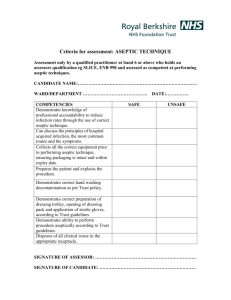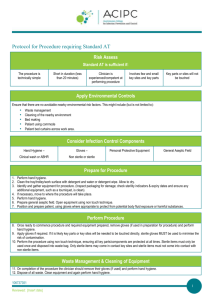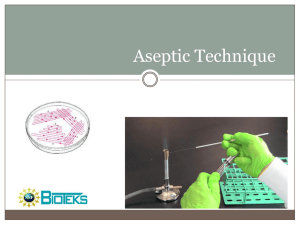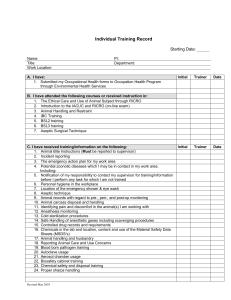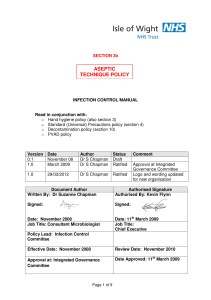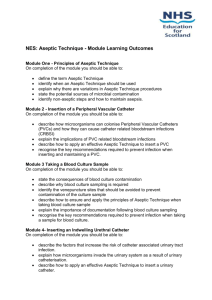Aseptic Technique
advertisement
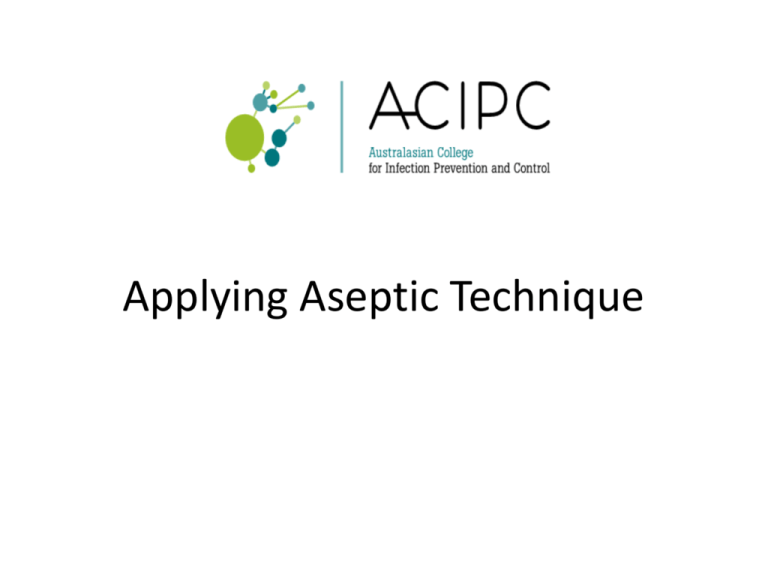
Applying Aseptic Technique What is Aseptic Technique? • Aseptic technique aims to prevent pathogenic organisms, in sufficient quantity to cause infection, from being introduced to susceptible sites by hands, surfaces and equipment. (National Health and Medical Research Council, 2010) • Aseptic technique protects patients during invasive clinical procedures by employing infection control measures that minimise, as far as practicably possible, the presence of pathogenic microorganisms. Why practice Aseptic Technique? • Aseptic technique reduces the risk of health care associated infections. • Aseptic technique is required for all invasive procedures. • Aseptic technique has been shown to significantly improve the practice of clinicians performing procedures and reduce the risk of infection. Aseptic Technique and HAI • Healthcare associated infections (HAI) are infections acquired in healthcare facilities and infections that occur as a result of healthcare interventions. • HAIs are caused by the transfer of pathogens to a patient during a healthcare intervention. • HAIs may manifest after people leave the healthcare facility. Preventing Infections using Aseptic Technique • Correct Aseptic Technique prevents contamination and transfer of pathogens from hands, surfaces and equipment to the patient during procedures. • Correct Aseptic Technique requires key parts and key sites to be identified and protected at all times. • Key parts must only come into contact with other key parts and / or key sites. What are Key Sites? • Key sites include any non-intact skin and insertion or access sites for medical devices connected to the patient. • Examples include insertion/access sites of intravenous devices, urinary devices, open wounds etc. What are Key Parts? • Key parts are the sterile components of equipment used during the procedure. • Examples include bungs, needle hubs, syringe tips, dressing packs etc. Preventing Infections using Aseptic Technique • There are several key Infection Control components to consider when performing any invasive procedure: 1. 2. 3. 4. 5. 6. Environmental Control Hand Hygiene PPE Selection Aseptic Field Management Non-touch technique Sequencing Environmental Control • Prior to aseptic procedures, clinicians must ensure that there are no avoidable nearby environmental risk factors, this might include (but is not limited to): – bed making – patients using commodes – waste management – cleaning of the nearby environment – patient bed curtains across work area Hand Hygiene • Effective hand hygiene is an essential component of Aseptic Technique. • Dependant on the procedure about to be performed either routine or surgical hand hygiene is required. • Routine Hand Hygiene refers to the use of soap/solution and water or an alcohol based hand rub. • Surgical hand scrub requires the use of an approved antimicrobial skin cleanser or waterless hand rub formulation. Routine Hand Hygiene Use of alcohol-based hand rub • Apply the amount of alcohol-based hand rub recommended by the manufacturer onto dry hands. • Rub hands together so that the solution comes into contact with all surfaces of the hand. • Pay particular attention to the tips of the fingers, the thumbs and the areas between the fingers. • Continue rubbing until the solution has evaporated and the hands are dry (approx 20-30 secs). Routine Hand Hygiene Routine Hand Hygiene Using soap (including antimicrobial soap) and water • Wet hands under tepid running water and apply the recommended amount of liquid soap. • Rub hands together for a minimum of 15 seconds so that the solution comes into contact with all surfaces of the hand, paying particular attention to the tips of the fingers, the thumbs and the areas between the fingers. • Rinse hands thoroughly under running water, then pat dry with single-use towels. Routine Hand Hygiene Surgical Hand Hygiene • Surgical hand preparations reduce the release of skin bacteria from the hands for the duration of the procedure. • Surgical hand preparation must eliminate the transient and reduce the resident flora. • See your facility’s specific policies and procedures on which product and methods of surgical hand hygiene must be followed. Protective Personal Equipment (PPE) Glove use: • Gloves are single-use items. • If it is necessary to touch key parts or key sites directly, sterile gloves must be used to minimise the risk of contamination. • If key parts or key sites are not touched directly nonsterile gloves may be necessary to protect the clinician from blood or body fluids or exposure to toxic drugs during administration. • Gloves do not replace the need for hand hygiene. Hand hygiene must be performed before and after glove use. Gloves (cont’d) • Selection of sterile or non-sterile gloves is also dependent upon clinician competency. • When preparing for the procedure clinicians should assess their own competence and experience in performing the procedure and determine whether touching of key parts or sites is required. • If touching may take place sterile gloves are required. Other PPE • Protective Personal Equipment (other than gloves) may be required if indicated to reduce the risk of blood and body fluid exposure to the clinician. • Maximum barrier precautions may be required during some procedures (such as CVC insertion) to reduce the risk to the patient of acquiring a healthcare associated infection. • Refer to your local policy and procedures to determine if maximum barrier precautions are necessary. Aseptic Field Management • Prior to commencing a procedure requiring AT, it is imperative the clinician determines the aseptic field required and how that field will need to be managed. • The aseptic field must be managed to ensure that key parts and key sites are protected. • The aseptic field should be prepared as close as possible to the time of actual use. Aseptic Field Management • The clinician should select a tray or trolley of an appropriate size to ensure key parts are adequately contained within the aseptic field. • The tray or trolley must be cleaned appropriately and allowed to dry before placing any items in or on the tray or trolley. If a surface remains wet then asepsis will be compromised. • The aseptic field may also need to be extended by draping the patient. The sterile drape will provide additional work space where sterile equipment may be placed as well as protecting the key site from contamination. General Aseptic Fields General aseptic fields are used when key parts are easily protected by critical micro aseptic fields and non-touch technique the main aseptic field does not have to be managed as a key part Asepsis of the immediate procedure environment is therefore promoted by general aseptic field management. Note: Management of the general aseptic field does require key parts be protected by a Critical Micro Aseptic field. What is a Critical Micro Aseptic Field? • Critical micro aseptic fields are those key parts protected by syringe caps, sheathed needles, covers or packaging. Critical Aseptic Fields Critical aseptic fields are used when• key parts/sites are large or numerous and can’t be easily protected by covers or caps or can’t be handled with a non-touch technique • invasive procedures require a large aseptic working area Management of the critical aseptic field requires only sterilised equipment to be placed in the aseptic field; sterile gloves are required to maintain asepsis. Non-touch Technique • Non-touch technique is an important component of AT, even when sterile gloves are used. • It is well documented that hand hygiene is not always correctly performed and that even correctly performed hand hygiene cannot always remove all pathogenic organisms. Therefore, a non-touch technique is a vital component of achieving asepsis. • Non-touch technique is a technique where the clinician’s hands do not touch, and thereby contaminate, key parts and key sites. The safest way to protect a key part is not to touch it. Sequencing • When performing a procedure, practice must be sequenced to ensure an efficient, logical and safe order of procedure events. • Practice guidelines provide direction as to the correct order in which preparation and completion of the procedure should be undertaken. • Clinicians should be familiar with the sequence of these events prior to commencing the procedure to ensure preparation for the procedure is complete and to ensure adherence to AT. Preparing for a Procedure Risk Assessment • Several factors will influence the type of aseptic technique that will be required for a particular procedure. • Before preparing for the procedure the clinician needs to determine: – The complexity of the procedure – Their own skill/experience and competency at performing the procedure – The key parts and key sites associated with that procedure – Whether the key parts or key sites need to be touched – What are the appropriate infection prevention measures to protect key parts and key sites. Types of Procedures Depending on the clinicians assessment of the complexity, their competency, duration and number of key parts and sites associated with a procedure, there are two types of Aseptic Technique. 1. Standard AT 2. Surgical AT Standard AT • Standard AT is required for clinical procedures that are: - technically simple - short in duration (approximately less than 20 minutes) - involve relatively few and small key sites and key parts The clinician should also feel competent and experienced to perform the procedure without touching key sites or parts. Standard AT requires a main general aseptic field and may permit the use of non-sterile gloves if no contact is being made with key parts and sites. The use of critical micro aseptic fields and a non-touch technique is essential to protect key parts and key sites Surgical AT • Surgical AT is required when procedures are: – technically complex, – long in duration (longer than 20 minutes) – involve large open key sites or numerous key parts OR – if the clinician is inexperienced or does not feel confident to perform the procedure without touching key sites or parts To counter these risks, a main critical aseptic field and sterile gloves are required and often full barrier precautions. Surgical AT should still utilise critical micro aseptic fields and non-touch technique where practical to do so. Part 1. Preparation • Once the clinician has determined whether the procedure requires standard or surgical AT they should apply any environmental control measures required and ensure access to the appropriate PPE. Part 2. Perform the Procedure • The procedure should be performed ensuring all key parts/components are protected at all times. • Sterile items must only be used once and disposed into waste bag. • Only sterile items may come in contact with key sites and sterile items must not come into contact with non-sterile items. Part 3. Waste Management • On completion of the procedure the clinician should remove their gloves (if used) and perform hand hygiene. • Dispose of all waste (including sharps) in the appropriate receptacle. Part 4. Cleaning of Equipment • On completion of the aseptic procedure and once hand hygiene has been performed, all equipment used during procedure should be thoroughly cleaned using detergent and when required followed by a disinfectant. • Cleaning followed by disinfection may be a two step or two in one process. • Ensure all touch surfaces that have been used are cleaned well. • Cleaned equipment should be allowed to dry properly before being put away. On completion of cleaning hand hygiene should be performed. Summary • Aseptic technique is required for all invasive procedures. • Aseptic technique reduces the risk of patients acquiring an infection by ensuring asepsis of hands, surfaces and equipment, thus minimising the risk of introduction of pathogenic material into susceptible sites on the patient. • Risk assessment is required to determine appropriate aseptic technique. Summary • Standard AT is required for clinical procedures that are technically simple, short in duration and involve relatively few and small key sites and key parts and the clinician is experienced and competent to perform the procedure without touching key sites or parts. • Surgical AT is required when procedures are technically complex, long in duration, involve large open key sites or numerous key parts or the clinician is inexperienced at performing the procedure and may require touching of key sites or parts. • Key sites and key parts should be protected at all times. • Non-touch technique is a vital component of achieving asepsis. References References: 1. Australian Commission on Safety and Quality in Health Care (ACSQHC). Windows into Safety and Quality in Health Care. Sydney, July 2009. 2. National Health and Medical Research Council (NHMRC). Australian Guidelines for the Prevention and Control of Infection in Healthcare. Commonwealth of Australia. Canberra 2010. 3. Hart S. Using an aseptic technique to reduce the risk of infection. Nurs Stand. Aug 1-7 2007;21(47):43-48. 4. Preston RM. Aseptic technique: evidence-based approach for patient safety. British Journal of Nursing. May 26-Jun 8 2005;14(10):540-542, 544-546. 5. Flodgren G, Conterno LO, Mayhew A, Omar O, Pereira CR, Shepperd S. Interventions to improve professional adherence to guidelines for prevention of device-related infections. Cochrane Database of Systematic Reviews. 2013;3:CD006559. 6. Rowley S, Clare S, Macqueen S, Molyneux R. ANTT v2: An updated practice framework for aseptic technique. British Journal of Nursing. 2010;19(5):S5-11. 7. Rowley S, Clare S. ANTT: a standard approach to aseptic technique. Nursing Times. 2011;107(36):12-14. 8. O'Grady N, Alexander M, Burns L, et al. Guidelines for the prevention of intravascular catheter-related infections. Am J Infect Control. May 2011;39(4 Suppl 1):S1-34. doi: 10.1016/j.ajic.2011.1001.1003. 9. Hand Hygiene Australia. Hand Hygiene Australia Manual. 3rd ed. Melbourne 2013. 10. World Health Organisation (WHO). WHO Guidelines on Hand Hygiene in Health Care. In: World Alliance for Patient Safety, ed. First Global Patient Safety Challenge Clean Care is Safer Care. Geneva: World Health Organisation Press; 2009. 11. Flores A. Sterile versus non-sterile glove use and aseptic technique. Nurs Stand. Oct 15-21 2008;23(6):35-39.
